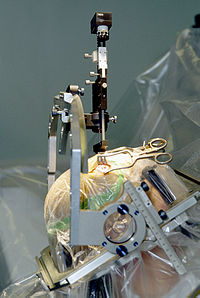
Photo from wikipedia
BACKGROUND Despite growing endovascular experience within the vascular surgery community, some catheter-based interventions-such as uterine artery embolization (UAE)-remain outside the clinical scope of most vascular surgeons, owing in part to… Click to show full abstract
BACKGROUND Despite growing endovascular experience within the vascular surgery community, some catheter-based interventions-such as uterine artery embolization (UAE)-remain outside the clinical scope of most vascular surgeons, owing in part to established referral patterns and limited awareness among referring colleagues. We present our experience with a vascular surgery-based, multidisciplinary UAE program at an academic tertiary referral center. METHODS In a collaborative effort between vascular surgeons and gynecologists, a pelvic vascular disease program has been established to provide palliative, prophylactic, and therapeutic embolizations including, but not limited to, UAE. For UAE, inclusion criteria are women over the age of 18 years with symptomatic uterine fibroids demonstrated on magnetic resonance imaging and a negative endometrial biopsy. Exclusion criteria are desire for future pregnancy and previous embolization(s). Technique and perioperative protocol is presented. Data including symptom resolution, reintervention rates, and complications were prospectively gathered and retrospectively reviewed. RESULTS Over an 18-month period, 30 patients with symptomatic fibroids were referred for potential UAE. Five patients were excluded because of uncertainty about future pregnancy wishes (4) and prior embolization (1). Twenty-four bilateral and 2 unilateral UAEs were performed (mean age, 46.3 years [range 28-53 years]). Presenting symptoms were pelvic and abdominal pain (25), cramps (25), menorrhagia (25), dysmenorrhea (25), urinary frequency (12), and dyspareunia (5). Technical success, defined as successful microcatheterization of uterine arteries and delivery of a particulate liquid embolic agent (embospheres, 500-700 microns), was 100%. There were no perioperative or delayed complications. Twenty-one patients (87.5%) reported complete symptomatic relief without further intervention at the time of last follow-up. Three patients (12.5%) reported pain relief but had persistent vaginal bleeding requiring hysterectomy 12 months after UAE. All patients underwent a 23-hr observation postoperatively for pain control. Mean follow-up was 7.4 months (1-23 months) and included pelvic ultrasound assessment of fibroid size at 1, 3, and 6 months after UAE and annually thereafter. One patient was lost to follow-up. Fibroid shrinkage was noted in all patients. Given the willingness and capability to work-up, admit, treat, and follow-up patients, vascular surgery was deemed the preferred service for UAE by the referring gynecologists. CONCLUSION Within the framework of a collaborative, multidisciplinary program, vascular surgery can play a prominent role in providing safe and effective UAE.
Journal Title: Annals of vascular surgery
Year Published: 2018
Link to full text (if available)
Share on Social Media: Sign Up to like & get
recommendations!